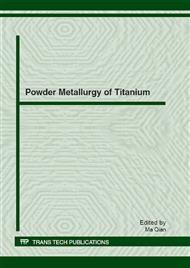[1]
C. Wen, M. Mabuchi, Y. Yamada, K. Shimojima, Y. Chino and T. Asahina, Processing of biocompatible porous Ti and Mg, Scripta Materialia. 45 (2001) 1147-1153.
DOI: 10.1016/s1359-6462(01)01132-0
Google Scholar
[2]
L. Chen, T. Li, Y. Li, H. He and Y. Hu, Porous titanium implants fabricated by metal injection molding, Transactions of Nonferrous Metals Society of China. 19 (2009) 1174-1179.
DOI: 10.1016/s1003-6326(08)60424-0
Google Scholar
[3]
S. W. Yook, B. H. Yoon, H. E. Kim, Y. H. Koh and Y. S. Kim, Porous titanium (Ti) scaffolds by freezing TiH2/camphene slurries, Materials Letters. 62 (2008) 4506-4508.
DOI: 10.1016/j.matlet.2008.08.010
Google Scholar
[4]
Y. Li, Z. Guo, J. Hao and S. Ren, Porosity and mechanical properties of porous titanium fabricated by gelcasting, Rare metals. 27 (2008) 282-286.
DOI: 10.1016/s1001-0521(08)60130-8
Google Scholar
[5]
X. Xu, M. I. L. L. Oliveira, R. Fu and J. M. F. Ferreira, Effect of dispersant on the rheological properties and slip casting of concentrated sialon precursor suspensions, Journal of the European Ceramic Society. 23 (2003) 1525-1530.
DOI: 10.1016/s0955-2219(02)00349-7
Google Scholar
[6]
M. P. Albano and L. B. Garrido, Processing of concentrated aqueous silicon nitride slips by slip casting, Journal of the American Ceramic Society. 81 (1998) 837-844.
DOI: 10.1111/j.1151-2916.1998.tb02417.x
Google Scholar
[7]
M. Kim, T. Yang, Y. Lee and H. Park, Dispersion stability of Y-TZP/Ce-TZP powder system and slip casting, Journal of materials science. 37 (2002) 1661 - 1665.
Google Scholar
[8]
Information on http: /www. wasanlab. com/pharm/flocc. html.
Google Scholar
[9]
Instruction Manual , Particle Charge Detection - PCD-03, Mutek, Germany, (1997).
Google Scholar
[10]
S. C. P. Cachinho and R. N. Correia, Titanium porous scaffolds from precursor powders: rheological optimization of TiH2 slurries, Powder Technology. 178 (2007) 109-113.
DOI: 10.1016/j.powtec.2007.04.014
Google Scholar
[11]
J. Zhang, F. Ye, J. Sun, D. Jiang and M. Iwasa, Aqueous processing of fine ZrO2 particles, Colloids and Surfaces A: Physicochemical and Engineering Aspects. 254 (2005) 199-205.
DOI: 10.1016/j.colsurfa.2004.12.012
Google Scholar
[12]
H. Sarraf, L. Skarpova and P. Louda, Influence of different anionic polyelectrolyte dispersants on the rheological and electrokinetic properties of carbon nanotubes, Annual Transactions-Nordic Rheology Society. 15 (2007) 253.
Google Scholar
[13]
J. Li, C. Van Blitterswijk and K. De Groot, Factors having influence on the rheological properties of Ti6A14V slurry, Journal of materials science: materials in medicine. 15 (2004) 951-958.
DOI: 10.1023/b:jmsm.0000042680.10087.15
Google Scholar


